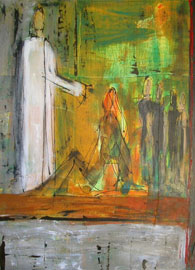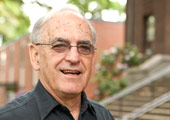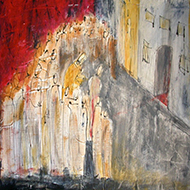Luke Week 5
“Miracles, Mission, Messiah”: Luke 7:1–9:50
By Mark Abbott
Seattle Pacific University Adjunct Instructor
Read this week’s Scripture: Luke 7:1–9:50
16:51

 Enlarge
Enlarge
In Malawi, Africa, I was in the back seat of a car headed to the capital toward nightfall. Westerners try not to be on the road after dark. Our vehicle was almost out of gas. A number of petrol stations, already checked, had no fuel because of a gasoline shortage in Malawi. A Malawian pastor traveling with us led us in fervent prayer. The next gas station on the road had fuel for sale. Was that just by chance? Was it a miracle? Was it God’s way of reminding this somewhat skeptical Westerner that God is still active in our world and takes care of his people?
In Bible times as well as today, miracles are not just interruptions of what we call “laws of nature.” Miracles are most importantly special signs of God’s presence, pointers to God and to God’s purposes.
In this week’s Lectio, John the Baptizer sends followers to inquire of Jesus, “Are you the one who is to come, or are we to wait for another?” Jesus’ answer:
Go and tell John what you have seen and heard: the blind receive their sight, the lame walk, the lepers are cleansed, the deaf hear, the dead are raised, the poor have good news brought to them (7:19–22).
Jesus’ miracles demonstrated that he was Messiah and that the kingdom of God had come near. This week’s Lectio includes no fewer than eight miracle stories! And they all point to who Jesus is.
Luke 7:1–16: Jesus’ Authority Over Disease and Death
Here’s a Roman military officer, highly regarded by synagogue leaders. He is deeply concerned for his dying servant. He appeals to Jesus through synagogue elders to come and heal his slave. As Jesus journeys to the centurion’s home, the officer sends a message expressing confidence that Jesus has only to speak a word and the slave will be healed. The centurion’s message: If I can exercise authority over my soldiers and over slaves in my household, you, Jesus, can certainly exercise authority to heal.
Jesus recognizes this confidence as a mark of great faith. “I tell you,” says Jesus to the crowd, “not even in Israel have I found such faith” (7:9). Faith, as expressed in the gospels, is not abstract belief about God or intellectual acceptance of a creed. In this story, faith is confidence in Jesus’ authoritative word.
In the next story (7:11–16), unique to Luke, there’s a widow whose only son has died. With nobody to care for her, she is in a precarious situation. Jesus’ response to this woman’s predicament is not in recognition of her faith, as with the centurion, but out of his own deep compassion. Jesus touches the stretcher bearing the dead body, something no good Jew would do for fear of ritual uncleanness. Jesus commands the dead man to get up. To everyone’s amazement he does! Again, in what we would call a miracle, Jesus’ expression of power makes clear who he is — God come near, God in the midst of our predicament.
Luke’s hearers would remember the story of Elijah, who also raised a widow’s son to life (1 Kings 17:17–24). In fact, Luke 7:15, “Jesus gave him to his mother,” is a direct quote from 1 Kings 17:23. The Elijah story concludes with the grateful widow declaring to Elijah, “Now I know that you are a man of God, and that the word of the LORD in your mouth is truth” (1 Kings 17:24).
These miracle stories, one about Jesus, and one from hundreds of years before, point to God at work through the healers — Jesus and Elijah. Again, miracles are not just setting aside the “laws of nature” but are evidence of God at work. “God has come to help his people!” (7:16) is the NIV translation of the people’s response to the miracle at Nain.
Luke 7:18–35: Jesus and John
John, now imprisoned by Herod Antipas, underling Galilean king, is lonely, discouraged, and uncertain about Jesus. Jesus responds to John’s inquiries by pointing to his own deeds of power, which express who he is.
And he answered them, “Go and tell John what you have seen and heard: the blind receive their sight, the lame walk, the lepers are cleansed, the deaf hear, the dead are raised, the poor have good news brought to them. (7:22)
The interaction between Jesus and John’s messengers opens up a conversation about John’s identity. But more importantly, who is Jesus?
Of John, Jesus declares: “[A]mong those born of women no one is greater than John; yet the least in the kingdom of God is greater than he” (7:28). Though he announces the coming of a new age, John belongs to the former age. In fact, John’s greatness lies in his unique mission to point to and prepare for God’s coming in Jesus.
Then the focus shifts from John to “the Son of Man” (7:33–35). The key issue has to do with eating and drinking practices. John was austere, “eating no bread and drinking no wine” (7:33), leading to complaints about him. Jesus appears to be the life of the party, and people complain about him, too. Jesus responds to this conundrum with a proverb: “Wisdom is vindicated by all her children” (7:35), or, as The Message paraphrases it, “Opinion polls don’t count for much, do they? The proof of the pudding is in the eating.”
Luke 7:36–8:3: Forgiveness and Faith
Luke moves from the discussion of an issue (Who is Jesus? How should we respond to him?) to a story that dramatizes the issue. Though there are similar-sounding stories in other gospels, we should let Luke’s story stand on its own.
There are three dramatic characters: Simon, a Pharisee; Jesus; and an unnamed, uninvited, reputed-to-be-loose woman. The setting, as seen frequently in Luke, is a meal.
Rather than a closed-off place, this dinner scene is played out in the open — as often was, and still is, the case in that culture. The poor and other passersby wander in off the street. Jesus and others recline on low couches with feet extended behind them. The woman brings expensive perfume, with which she anoints Jesus’ feet. Overcome with emotion, she bathes his feet with her tears and dries them with her long hair. An adult woman with her hair exposed would be considered promiscuous, a “loose” woman.
Watching this drama play out before him, the host says to himself, “If this man were a prophet, he would have known who and what kind of woman this is who is touching him — that she is a sinner.” (7:39). Jesus responds to Simon’s thoughts with a story. Two debtors cannot pay up. One owes a huge sum (a working man’s wages for a year and a half), the other a nominal amount (six or seven weeks’ wages). The creditor cancels both debts. Which debtor will love the benefactor more? Simon gives the obvious answer, “I suppose the one for whom he canceled the greater debt” (7:43).
Jesus turns the tables on his host, who has apparently neglected to be carefully hospitable.
You did not anoint my head with oil, but she has anointed my feet with ointment. Therefore, I tell you, her sins, which were many, have been forgiven; hence she has shown great love … Then he said to her, “Your sins are forgiven” (7:46–48).
Jesus then says to the woman, “Your faith has saved you; go in peace” (7:50).
In this case, is not faith the grateful reception of divine forgiveness? True faith is looking to Jesus and receiving his forgiveness. The sign of that faith is love for the one who so mercifully forgives. Meanwhile, onlookers give evidence of their lack of faith by complaining, “Who is this who even forgives sins?” (7:49). We are back to Jesus’ identity being proclaimed by what he does — his miracles and his forgiveness of sins.
True to his interest in the women of Jesus’ story, Luke transitions from the forgiven and faithful woman in the story just told, to women who travel with Jesus and provide for the disciple band from their own resources. These are women who, like the “loose woman” in the story, owe much to the healing, liberating power of Jesus (8:1–3).
Luke 8:4–39: A Sower, a Storm, and a Spirit-possessed Man
One of Jesus’ best-known parables, found in all synoptic gospels, is about a farmer sowing seed and the different kinds of soil into which the seed falls. Jesus’ story, however, is not about farming but about ways different groups of people respond to the message of God’s kingdom. Some are hard and unresponsive like a path’s surface at the field’s edge. Others respond quickly, but growth is short-lived due to growth-hampering adversities.
Then there are those who again respond right away, but whose response is choked by “thorns,” “cares and riches and pleasures of life, and their fruit does not mature” (8:14). Finally, there are those who respond positively but also with “patient endurance” (8:15) to the word of the kingdom. Maybe Jesus is thinking of people like the Roman centurion or the woman at Simon’s house who responded in faith and love to Jesus.
A few verses later: Stormy sea, fearful disciples, Jesus asleep in the boat but aroused to calm the wind and waves — all lead to amazement about Jesus and more questions about his identity. “Who then is this, that he commands even the winds and the water, and they obey him?” (8:25). Notice again how miracles point to who Jesus is and to his authority.
In a predominantly non-Jewish area on the other side of the lake (probably today’s Golan Heights), the healing of a man who had been evil spirit-possessed creates a furor. Those whose herd of pigs is destroyed by departing evil spirits and those people who are afraid of such power at work in their area ask Jesus to leave (8:37). The formerly deranged man, now “clothed and in his right mind” (8:35), proclaims what Jesus has done for him. Jesus’ authority extends to the world of demons.
Luke 8:40–56: A Healing Within a Healing
Jesus is now back on the western, Jewish, side of the lake, important because the next healings involve issues of Jewish law. The framing story is about the daughter of Jairus, a synagogue official. The inserted story involves a hemorrhaging woman. As Jesus is responding to the impassioned request of Jairus for his 12-year-old daughter, our Lord encounters another sick person. Her hemorrhaging makes this woman ceremonially unclean, preventing her from engaging in public worship, where others could become unclean by contact with her.
Nevertheless, she presses through the crowd of people around Jesus so she can touch the fringe of his clothing. She is healed! Jesus knows that someone touched him and “noticed that power had gone out” from him (8:46). The unnamed woman acknowledges what she did. Jesus responds to her: “Daughter, your faith has made you well; go in peace” (8:48). Notice again Jesus’ reference to faith. In this woman’s case, is not faith persevering to reach out and touch Jesus in her need?
We return to the journey of Jairus and Jesus to heal the sick daughter. By now, the girl has died. When he hears this news, Jesus encourages Jairus, “Do not fear. Only believe [have faith], and she will be saved” (8:50). Here, what Jesus calls faith is a willingness to persevere in placing human need before Jesus. Jesus, already made ceremonially unclean by the hemorrhaging woman’s touch, now deliberately touches a dead body, incurring double pollution. Ignoring those who have begun customary wailing for the dead, Jesus takes the girl by the hand and tells her to get up. And she does!
Luke 9:1–17: The 12 on Mission for Jesus and With Jesus
In these miracle stories, Jesus shows himself as the Messiah who gets his hands dirty in humanity’s problems. Jesus will shortly try to help his followers understand what kind of messiah he is: One who will undergo suffering, rejection, death, and resurrection. But first, Jesus sends the 12 disciples out in mission “to proclaim the kingdom of God and to heal” (9:2). Curing diseases and preaching good news send a ripple through the area reaching even to King Herod (9:9).
Returning to Jesus, the 12 go on retreat with their master. But the retreat is interrupted when crowds find Jesus in “a deserted place” (9:12). As preaching and healing continue, disciples find a modest lunch of five loaves and two small fish. Jesus blesses and distributes the food through the disciples, and 5,000 men are fed. So the disciples are on mission for Jesus as they are sent out in his name. And they are on mission with Jesus as they take food from his hands and feed hungry people.
Luke 9:18–36: Who Do You Say That I Am?
The public opinion poll question, “Who do the crowds say that I am?” leads to a personal question for the disciples, “Who do you say that I am?” “The Messiah of God,” Peter declares.
But Jesus explains what kind of messiah he is. Later on, Jesus says to uncomprehending disciples, “Let these words sink into your ears: The Son of Man is going to be betrayed into human hands” (9:44). Jesus applies who he is to who his followers must be. A disciple is to draw identity from that of the leader. Those who follow a leader who suffers on behalf of his followers become men and women willing to “take up their cross daily and follow [him]” (9:23). Jesus’ followers must be willing to “lose their life for [Jesus’] sake” (9:24). Jesus’ followers must forsake quests for human power and glory, recognizing that “the least among all of you is the greatest” (9:48).
Balancing emphases on suffering and dying, Jesus also shows himself in glory to his three closest followers, Peter, James, and John. Moses and Elijah appear with Jesus “speaking of his departure, which he was about to accomplish at Jerusalem” (9:31). The glory of the mountaintop experience turns into mundaneness in our everyday lives, which are filled with human need. There’s a desperate situation the disciples cannot deal with, but to which Jesus brings healing.
Who is Jesus? How do we engage in his mission? What does that look like in everyday life? And what does it mean to have faith in Jesus? These are questions raised nearly 2,000 years ago by Luke. This Lectio ends with a brief but telling vignette. John tries to stop someone from casting out demons because he’s not part of the Jesus group. “But Jesus said to him, ‘Do not stop him, for whoever is not against you is for you’” (9:50). The identity and mission of Jesus are not about forming an exclusive group for us and only us. They are rather about extending good news to all who will listen and respond.
Questions for Further Reflection
- Put yourself in one of these miracle stories. Try to visualize it occurring today. What does it feel like? How do you respond to what Jesus does?
- How does assurance of forgiveness make us feel? Do we sometimes struggle with receiving the forgiveness Jesus freely offers us?
- Consider the situations in which Jesus comments on the presence of faith. How do these understandings of faith differ from ways in which you have understood faith?
- What does it mean for us to “take up our cross?” What does it mean to do so daily?
<<Previous Lectio Back to Luke Next Lectio>>

This work is licensed under a Creative Commons License.






I needed to hear this today. I recently was diagnosed with stage 3 colon cancer. The Doctor said it is treatable and the prognosis is very good. However, it was the promise of healing that God answered my prayer in John 11:4. “This sickness is not unto death, but for the glory of God, that the Son of God might be glorified thereby” Jesus comes back in verse 40 with a challenge of faith: ” “Said I not unto thee, that, if thou would believe, that thou should see the glory of God?” Truly, my faith is being strengthened through this, and as He draws near me with healing, that Jesus might be glorified thereby. Wednesday, I see the Onocologist to see what kind of chemo is needed for the “traces left in one of my 24 lymph glands by my colon. So far, God has done the miracle, please pray that even the “traces’ are gone and have been healed.
Thank you for the timing of this devotional.
Marty
Marty–
Thank you so much for your note. Praying for God’s powerful healing work to be done in your life as you journey through these next days and weeks. So glad to hear that the Lectio was a word of encouragement to you amid your diagnosis.
Blessings,
CBTE Staff
Dear friends,
could you do me a favor and tell me, who the painter of these awesome two pictures is?
Best wishes
dh.
Hi Dirk– These pieces are by an artist by the name of Barbara Februar. They’re beautiful, aren’t they?